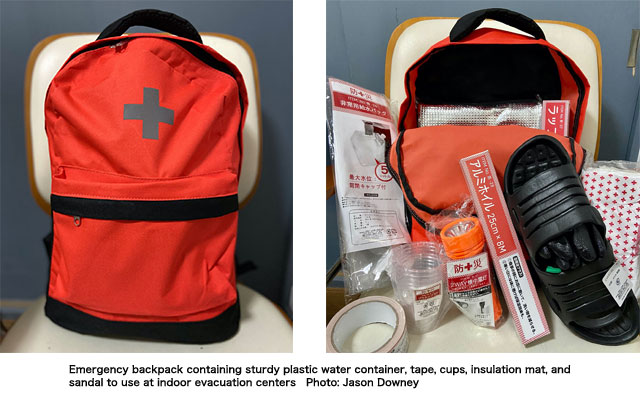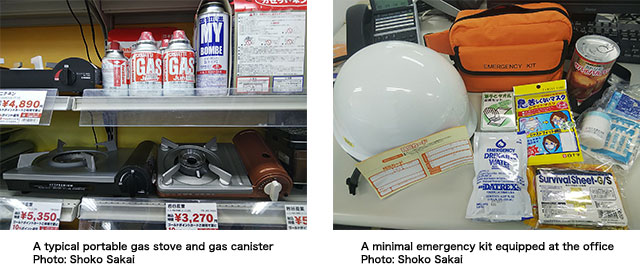News
February - Preparing Emergency Kits Updated in February 2020
Following a major disaster, public access to food, water, electricity, and sewage may be cut off for days or even weeks. Keeping a small stockpile of necessary items to help you survive this critical period should be a top priority for everyone in Japan.
Emergency survival bags are backpacks filled with 2-3 days’ worth of essential items in case you can’t continue to live at home during the crisis. One bag should be prepared for each member of your household, and should be prepared to meet any specific needs they may have. Bags for adult men and women will differ from those of children and elderly people. Bags should contain several categories of items:

Food & Water
- several bottles of water
- ready-to-eat foods with long shelf-lives (crackers, chocolates, candies, energy-bars, etc)
Wearables
- a helmet
- waterproof outerwear
- socks
- underwear
- work gloves
- a blanket
Tools
- a flashlight
- batteries/fully charged mobile battery for smartphone
- an army knife
- a portable radio
- tape
Sanitary Supplies
- bandages
- masks
- portable toilets
- toothbrushes
Copies of your passport, resident card, health insurance card, and other identification documents will make regaining access to public services much smoother in case the originals are lost or destroyed.
Waterproofing items like clothing, paper, and emergency cash is as simple as placing them in sealable plastic ziploc bags.
There are many more items that may be essential for your emergency bag, depending on the person:
- women need to prepare menstrual hygiene products;
- people who wear eyeglasses may want to pack an extra pair;
- people on special medication should keep a supply in this bag;
- elderly people may need items such as hearing aids, walking sticks, or dentures;
- and children’s needs must be considered based on their age, but babies/toddlers may need bottles, diapers, and baby food.
Geography or climate must be taken into account, too. An emergency bag stocked for a winter in Nagano will look different from one prepared for a summer in Wakayama. Knowing your neighborhood’s specific risks (to earthquake, flood, and fire), local evacuation areas, and emergency water reserves will help you plan better for your particular circumstances.
Preparing an emergency bag is important, but it’s not the only thing that needs preparing. Keeping a stockpile of emergency supplies at home is also strongly recommended. Buy a portable stove and gas canisters, disposable utensils, first aid kits—and a daily stockpile of food. Build this stockpile to last at least three days, and ideally seven to ten. It’s not necessary to separate this stockpile from the rest of your food; simply buy a bit more of what you usually buy. This will create a “rolling stock” at your home that you can maintain.

Water will be the most difficult resource to preserve; three liters per person per day is recommended. A detailed list of recommended items can be found on page 89 of “Tokyo Bosai”, the official disaster preparedness manual of the Tokyo Metropolitan Government.
Useful tips from disaster survivors:
- Keep some ready-to-eat frozen food in your freezer. Once the electricity goes out, you can start eating/cooking the defrosted food before you start touching your stockpile.
- Put new plastic clingwraps directly over paper plates every time you eat and you can re-use paper plates.
- Always fill your bathtub with tap water, so that you can drink it after boiling; cup ramen is not a good stockpile as it needs lots of water to cook.







